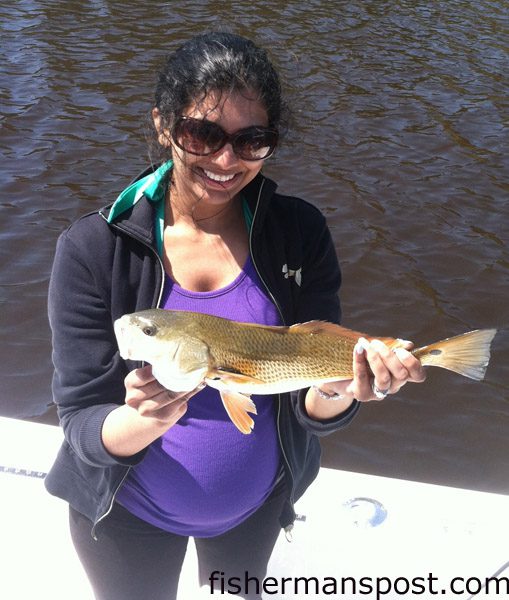Swansboro April 25, 2013

Tony Futrell, of Oxford, NC, with a 10 lb. bluefish he landed on a sea mullet rig in 20 lb. mono after it struck a piece of shrimp on the Swansboro waterfront. he was fishign with Capt. Rob Koraly of Sandbar Safari Charters.
Rob, of Sandbar Safari Charters, reports there are big numbers of red drum working the flats and creeks around Swansboro and Emerald Isle recently (with most fish under/lower-slot but some larger ones around as well), but they’ve been a bit tough to get to bite with the inconsistent weather. Cut baits and live mud minnows have been the best bets for tempting bites from the reds over the past week, but anglers are hooking up on Gulp baits as well.
Gray trout and sea mullet have shown up in the deeper channels and holes inshore, with the Swansboro waterfront producing some of the best action. Fresh shrimp on bottom rigs have been fooling plenty of both of the bottom feeders.
The grays are also feeding at nearshore bottom structure in the ocean, where a Stingsilver or other jigging lure will tempt them to bite.
Some chopper bluefish are also feeding inshore, and one angler landed a 10 lb. blue on a sea mullet rig last week.
Robbie, of Hall’Em In Charters, reports that there are big schools of drum feeding in the backwaters behind the barrier islands lately (with some schools made up entirely of upper to over-slot fish). Searching for the schools and sight-casting is the best bet for connecting with big numbers of the reds, but windy conditions have made that a tough task on many recent days. Casting to grass points, oyster bars, and other likely congregating spots for the reds is producing action when anglers can’t locate the schools by sight.
The reds have begun to show an interest in topwater plugs, and anglers can fool them with soft plastic baits like Gulps and Zoom Flukes when they don’t want to feed on the surface. When the bite’s particularly tough, cut mullet is hard to beat, as the scent will draw the fish in from a distance.
Chopper bluefish (many 5-8 lbs.) have shown up inshore and are surprising anglers casting for the reds on occasion.
The speckled trout bite has slowed down a bit in the White Oak River, but anglers are still finding a few fish while working Flukes, MR17’s, and other artificial lures.

Mariyam Cherry, of TX, with a red drum she hooked in the White Oak River while fishing with Capt. Chris Sewell of Fishead Charter.
Sea mullet are feeding around the Swansboro waterfront (with many running 1 lb. and larger). Some gray trout are feeding alongside the mullet, and clam-flavored Fish Bites pinned to double-hook bottom rigs have been the most productive bait for both bottom feeders recently.
Rich, of The Reel Outdoors, reports that anglers are starting to hook flounder inshore, in the surf, and around the artificial reefs and other structure in the ocean. Live baits and Gulp soft lures are fooling the flatfish inshore and in the breakers, and 2 oz. bucktails tipped with Gulps are the best bets in the ocean.
Some speckled trout have also been feeding on the beachfront lately and taking an interest in MirrOlures and soft plastic baits.
Anglers are still connecting with the specks and puppy drum in the creeks and backwaters inshore, where live baits or a variety of artificials will tempt them to bite.
Surf and pier anglers are finding some solid sea mullet and pufferfish action while soaking shrimp and other baits on double-hook bottom rigs.
Offshore anglers are still seeing some action with wahoo and blackfin tuna when the seas calm enough to make a run to the break. Trolled ballyhoo are tempting bites from both.
Mike, of Bogue Inlet Pier, reports that anglers are connecting with some sea mullet, bluefish, black drum, and a few spots recently. Some of the blues have been larger choppers (to 7 lbs.), and they’re taking an interest in cut baits.
Most of the bottom feeders are falling for shrimp on double drop rigs.
The water temperatures have dropped by 10 degrees in the past week, but anglers have already seen the first keeper flounder and pompano of the season, so more should be on the way once the water climbs back into the mid-60’s.
